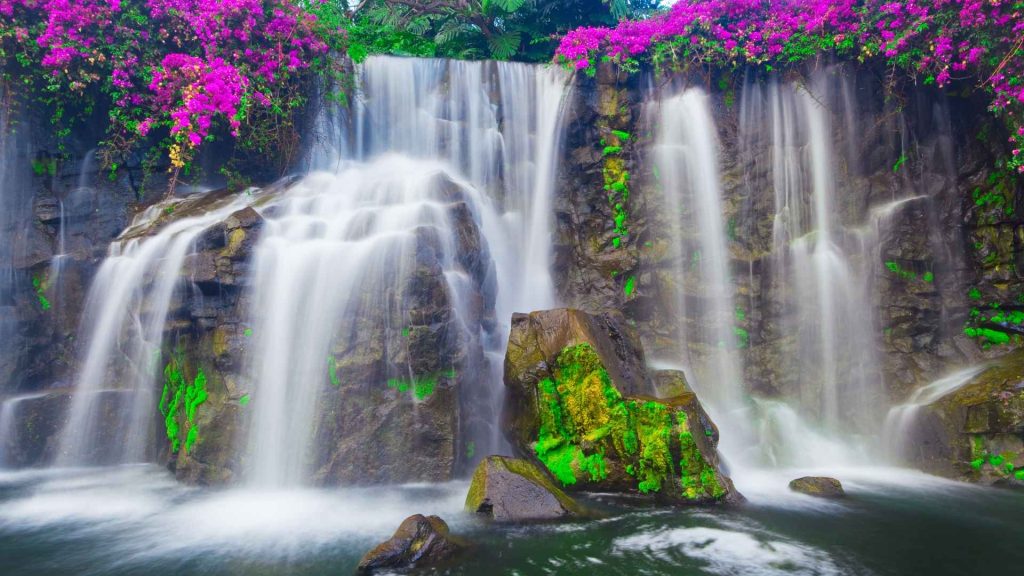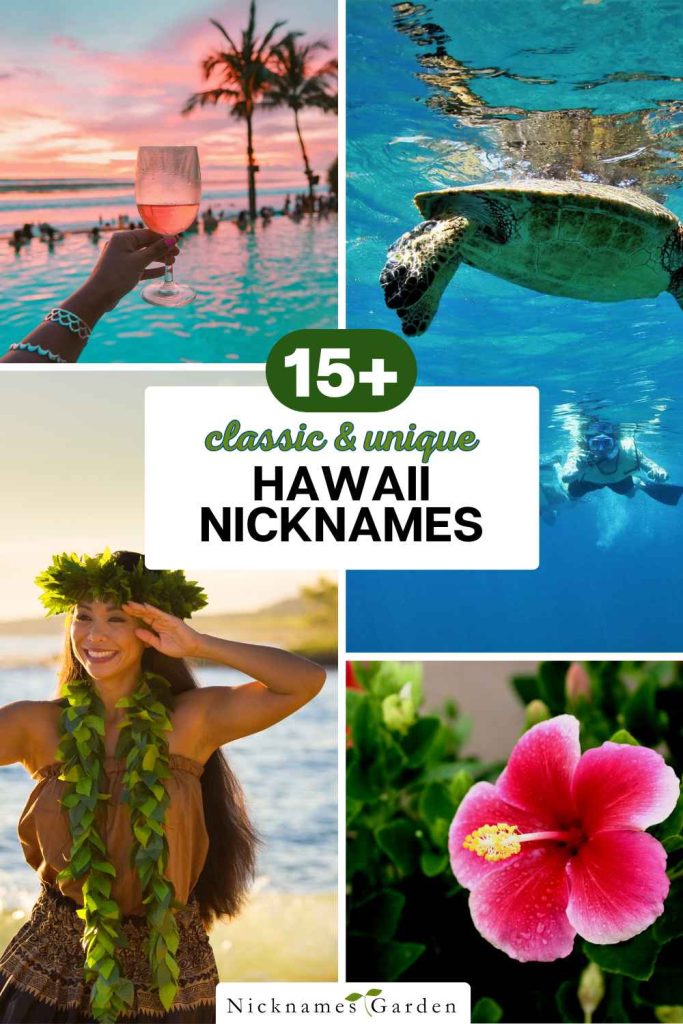Hawaii, a place of breathtaking beauty and rich culture, has earned many nicknames over the years.
From “The Aloha State” to “The Paradise of the Pacific,” each name tells a unique story. Dive into this ultimate guide to uncover the fascinating history and meanings behind Hawaii’s many monikers.
Popular Nicknames for Hawaii
The Aloha State
Origin and History:
“The Aloha State” is Hawaii’s official nickname, adopted when Hawaii became the 50th state of the United States in 1959.
The term “aloha” holds deep cultural significance in Hawaii, encapsulating the essence of Hawaiian hospitality and kindness.
Meaning of “Aloha”:
“Aloha” means more than just “hello” and “goodbye” in Hawaiian. It embodies love, peace, compassion, and a mutual respect for others.
This spirit of aloha is an integral part of daily life in Hawaii and is reflected in the islanders’ warm and welcoming nature.
Cultural Representation:
The nickname “The Aloha State” not only highlights the welcoming spirit of Hawaii’s people but also serves as a reminder of the island’s unique cultural heritage.
The concept of aloha is a cornerstone of Hawaiian culture, influencing social interactions and community bonds. It underscores Hawaii’s reputation as a place of warmth and friendliness, attracting millions of visitors each year.
The Islands of Aloha
Explanation of the Phrase:
“The Islands of Aloha” is another popular nickname for Hawaii, emphasizing the pervasive presence of aloha throughout all the islands.
This phrase showcases the collective identity of the Hawaiian Islands as a unified place where the spirit of aloha is celebrated and lived.
Historical Context:
The phrase gained popularity as Hawaii became a major tourist destination in the mid-20th century.
It encapsulates the unified and harmonious nature of the Hawaiian archipelago, promoting the islands as places where visitors can experience true aloha.
Cultural Significance:
This nickname reinforces the idea that aloha is not confined to one island but is a shared cultural treasure among all the Hawaiian Islands.
It highlights the interconnectedness of the islands and their people, promoting a sense of unity and shared cultural values.
The Paradise of the Pacific
Origins of the Nickname:
“The Paradise of the Pacific” was coined by early travelers and writers enchanted by Hawaii’s natural beauty. This nickname reflects the island’s idyllic landscapes, pristine beaches, and lush tropical flora.
Why Hawaii is Considered a Paradise:
Hawaii’s stunning scenery, including its crystal-clear waters, volcanic mountains, and vibrant rainforests, contributes to its image as a paradise.
The pleasant climate and diverse ecosystems further enhance this perception, making Hawaii a dream destination for many.
Cultural and Tourism Impact:
This nickname plays a significant role in attracting tourists seeking a tropical escape.
The portrayal of Hawaii as a paradise boosts its appeal as a premier vacation spot, contributing significantly to the state’s economy through tourism.
The 50th State
Historical Background on Hawaii’s Statehood:
Hawaii’s journey to statehood culminated on August 21, 1959, when it officially became the 50th state of the United States.
This was a pivotal moment in Hawaii’s history, marking its full integration into the United States.
Significance of Being the 50th State:
As the newest state, Hawaii represents the expansion and diversity of the United States.
This nickname highlights Hawaii’s unique position as the only U.S. state composed entirely of islands and its distinct cultural heritage.
Impact on Hawaiian Identity:
Statehood brought significant political and economic changes to Hawaii, blending native Hawaiian culture with American influences.
The nickname “The 50th State” serves as a reminder of Hawaii’s dual identity as both a traditional Polynesian society and a modern American state.
The Rainbow State
Origins of the Nickname:
Hawaii is often called “The Rainbow State” due to the frequent occurrence of rainbows across the islands.
The combination of sun and rain showers creates perfect conditions for rainbows, making them a common and beautiful sight.
Frequency and Significance of Rainbows in Hawaii:
Rainbows are an almost daily occurrence in Hawaii, often seen arching over mountains, valleys, and the ocean.
They are celebrated in Hawaiian culture and are considered symbols of hope, promise, and beauty.
Symbolism in Hawaiian Culture:
In Hawaiian mythology, rainbows are associated with gods and serve as bridges to the heavens. They symbolize prosperity and are often seen as positive omens.
The nickname “The Rainbow State” reflects Hawaii’s natural beauty and cultural reverence for this stunning natural phenomenon.

Hawaii Nicknames Based on Geography and Nature
The Pineapple State
History of Pineapple Cultivation in Hawaii:
Pineapples were first introduced to Hawaii in the early 19th century. By the early 20th century, pineapple cultivation had become a significant industry, largely due to the efforts of companies like Dole and Del Monte.
The industry’s growth transformed the landscape of Hawaii, with vast plantations covering many areas.
Economic and Cultural Impact:
At its peak, Hawaii was one of the world’s leading producers of pineapples, contributing significantly to the state’s economy.
The pineapple industry not only provided jobs but also influenced the cultural identity of Hawaii, making pineapples a symbol of the islands.
Famous Pineapple Plantations and Products:
The Dole Plantation on Oahu is one of the most famous pineapple plantations and a popular tourist attraction.
Hawaii’s association with pineapples has led to the creation of numerous pineapple-based products, from fresh fruit to canned goods, that are exported worldwide.
The Volcanic Isles
Geographical Explanation:
Hawaii’s islands are volcanic in origin, formed by volcanic activity from the Hawaiian-Emperor seamount chain.
This geological process has created the unique landscapes and diverse ecosystems found throughout the islands.
Historical Eruptions and Their Impact:
Hawaii is home to some of the world’s most active volcanoes, including Kilauea and Mauna Loa. Historical eruptions have dramatically shaped the islands’ topography, creating new land and influencing the environment.
Cultural Significance of Volcanoes in Hawaiian Mythology:
In Hawaiian mythology, Pele, the goddess of fire and volcanoes, is a central figure. She is believed to reside in the Halemaʻumaʻu crater at Kilauea.
The volcanic activity is seen as a manifestation of Pele’s power and presence, and many cultural traditions and stories are tied to her.
The Orchid Isle
Origin of the Nickname:
The nickname “The Orchid Isle” refers to the Big Island (Hawaii Island) due to its abundance of orchids. The island’s diverse climate zones create ideal conditions for growing these exotic flowers.
Significance of Orchids in Hawaii:
Orchids are highly prized for their beauty and variety. They are often used in leis and as decorative plants. Hawaii’s orchid industry is a significant part of its agricultural sector, with many orchids being exported worldwide.
Economic and Botanical Importance:
The Big Island is home to numerous orchid nurseries and botanical gardens. The annual Hawaii International Orchid Show attracts enthusiasts and experts from around the globe, highlighting the island’s importance in the orchid world.
The Big Island
Explanation of the Nickname:
The term “The Big Island” is used to distinguish Hawaii Island from the state of Hawaii. It is the largest island in the Hawaiian archipelago, with a land area of over 4,000 square miles.
Historical and Geographical Context:
The Big Island’s vast size and diverse landscapes include everything from sandy beaches to snow-capped mountains. It is home to 11 of the world’s 13 climate zones, offering a variety of environments within a single island.
Differences from Other Hawaiian Islands:
Unlike the other islands, the Big Island has a unique combination of active volcanoes, lush rainforests, and arid deserts. This diversity makes it a microcosm of the natural beauty found throughout the Hawaiian Islands.

The Garden Isle
Origin and Meaning of the Nickname:
Kauai is known as “The Garden Isle” because of its lush, green landscapes. The island receives abundant rainfall, particularly in areas like Mount Waialeale, one of the wettest spots on earth.
Natural Beauty and Flora of Kauai:
Kauai is famous for its tropical rainforests, dramatic cliffs, and waterfalls. The island’s fertile soil supports a wide variety of plant life, including exotic flowers and native Hawaiian species.
Cultural and Touristic Significance:
The natural beauty of Kauai attracts tourists looking for outdoor adventures and scenic views. Popular sites like the Na Pali Coast, Waimea Canyon, and the island’s botanical gardens draw visitors from around the world.
The Valley Isle
Explanation and Origin of the Nickname:
Maui is called “The Valley Isle” due to its central valley, which is surrounded by two volcanic mountain ranges, the West Maui Mountains and Haleakala.
Geographical Features of Maui:
Maui’s landscape includes lush valleys, volcanic craters, and pristine beaches. The island is known for its diverse environments, from the arid slopes of Haleakala to the tropical rainforests of Hana.
Cultural Importance of Valleys in Hawaiian History:
Valleys have historically been vital for agriculture and settlement in Hawaii. The fertile valleys of Maui provided resources for early Hawaiian communities and continue to be important for local agriculture.
The Gathering Place
Origin and Significance of the Nickname:
Oahu is known as “The Gathering Place” because it has long been a central hub for the Hawaiian Islands. Historically, it was a meeting point for different cultures and people.
Historical and Cultural Context of Oahu:
Oahu is the most populous island in Hawaii and the site of the state capital, Honolulu. It has been a cultural and political center for centuries, playing a crucial role in Hawaii’s history.
Modern-Day Relevance:
Today, Oahu continues to be a gathering place, attracting residents and visitors from around the world. It is the economic and tourism heart of Hawaii, home to landmarks like Waikiki Beach, Pearl Harbor, and Diamond Head.
The Friendly Isle
Explanation and History of the Nickname:
Molokai is called “The Friendly Isle” due to its welcoming and close-knit community. The island’s residents are known for their hospitality and strong sense of tradition.
Cultural Characteristics of Molokai:
Molokai preserves many traditional Hawaiian practices and lifestyles. The island has a slower pace of life and a strong sense of community, making it unique among the Hawaiian Islands.
Impact on Tourism and Local Identity:
Molokai attracts visitors seeking an authentic Hawaiian experience, away from the more commercialized areas. The nickname “The Friendly Isle” highlights the island’s commitment to preserving its cultural heritage and fostering a welcoming environment.
The Forbidden Isle
History and Origin of the Nickname:
Niihau is known as “The Forbidden Isle” because access to the island is highly restricted. It is privately owned by the Robinson family, who have maintained its isolation to preserve traditional Hawaiian culture.
Cultural and Historical Significance of Niihau:
Niihau has a unique cultural and historical significance. The island’s residents live a traditional Hawaiian lifestyle, speaking Hawaiian as their primary language and maintaining customs that have been lost elsewhere.
Current Status and Access Restrictions:
Today, Niihau remains off-limits to most outsiders, with only a few controlled tours allowed. This isolation helps protect the island’s cultural heritage and natural environment.
The Pineapple Island
Explanation and History of the Nickname:
Lanai was once known for its extensive pineapple plantations, earning it the nickname “The Pineapple Island.” In the early 20th century, the island was largely owned by James Dole, who turned it into the world’s largest pineapple plantation.
Economic History of Lanai:
Pineapple production was a major economic activity on Lanai for many years. The island’s economy was heavily reliant on the pineapple industry, which employed a large portion of its residents.
Current Significance and Tourism:
Today, Lanai is known for its luxury resorts and preserved natural landscapes. While the pineapple industry has diminished, the island’s history as “The Pineapple Island” remains a significant part of its identity.
Lesser-Known Nicknames
The Surfing Capital of the World
History of Surfing in Hawaii:
Hawaii is widely regarded as the birthplace of surfing. Ancient Hawaiians, including chiefs and royalty, practiced surfing as a cultural and spiritual activity. The sport was revitalized in the early 20th century by figures like Duke Kahanamoku, who helped popularize surfing worldwide.
Cultural Significance of Surfing:
Surfing is more than just a sport in Hawaii; it’s a way of life. It embodies the spirit of aloha and the deep connection Hawaiians have with the ocean. Surfing is celebrated through numerous competitions, festivals, and everyday practice by locals and visitors alike.
Famous Surfing Spots:
Hawaii boasts some of the world’s most renowned surfing spots, including Waikiki Beach on Oahu, Pipeline on the North Shore, and Honolua Bay on Maui. These locations attract surfers from around the globe, cementing Hawaii’s reputation as the “Surfing Capital of the World.”
The Land of Eternal Summer
Explanation of the Nickname:
Hawaii’s nickname, “The Land of Eternal Summer,” reflects its consistently warm and pleasant climate year-round. Unlike many places that experience distinct seasons, Hawaii enjoys a mild, tropical climate that attracts tourists seeking sunny weather.
Climate and Weather Patterns:
Hawaii’s climate is characterized by warm temperatures, moderate humidity, and gentle trade winds. The islands receive varying amounts of rainfall, with the windward sides generally being wetter and the leeward sides drier.
Impact on Lifestyle and Tourism:
The favorable climate allows for a wide range of outdoor activities, such as surfing, hiking, and snorkeling, to be enjoyed year-round. This perpetual summer is a major draw for tourists and contributes significantly to Hawaii’s appeal as a vacation destination.

The Hula State
Origins of Hula Dancing in Hawaii:
Hula is a traditional Hawaiian dance that dates back centuries. It was originally performed as a religious ritual to honor the gods and tell stories of the islands’ history and mythology. Hula is accompanied by chants (oli) or songs (mele) and can be performed with or without instruments.
Cultural Importance and History:
Hula is deeply embedded in Hawaiian culture, serving as a means of preserving and passing down knowledge, history, and cultural values. Despite attempts to suppress it during the missionary era, hula has survived and flourished, becoming a symbol of Hawaiian identity and pride.
Modern-Day Relevance and Festivals:
Today, hula is celebrated both in Hawaii and around the world. Events like the Merrie Monarch Festival, an annual hula competition in Hilo, showcase the artistry and cultural significance of hula.
The dance continues to evolve while maintaining its traditional roots, making Hawaii rightfully known as “The Hula State.”
The Luaus State
History and Significance of Luaus:
A luau is a traditional Hawaiian feast that includes music, dancing, and an abundance of food. Luaus have been an integral part of Hawaiian culture for centuries, often held to celebrate important events such as births, weddings, and harvests.
Cultural and Social Importance:
Luaus are a way for Hawaiians to come together, celebrate, and share their culture with others. The communal aspect of luaus fosters a sense of unity and reinforces the importance of ‘ohana (family) and community in Hawaiian society.
Modern Celebrations and Tourism Impact:
Today, luaus are popular attractions for tourists, offering a glimpse into Hawaiian traditions and hospitality.
These events typically feature traditional foods such as kalua pig, poi, and lomi-lomi salmon, along with hula performances and other cultural presentations. Luaus play a significant role in promoting Hawaiian culture and enhancing the tourism experience.
Conclusion
These lesser-known nicknames highlight specific aspects of Hawaii’s rich cultural heritage and natural beauty.
From the exhilarating waves of the surfing capital to the timeless traditions of hula and luaus, these monikers add depth to the understanding of what makes Hawaii unique. Each nickname offers a glimpse into the diverse experiences and cultural treasures that the islands have to offer.
Modern Nicknames
The Ultimate Vacation Spot
Explanation and Origin:
Hawaii is often referred to as “The Ultimate Vacation Spot” due to its unparalleled natural beauty, diverse activities, and welcoming atmosphere. This nickname highlights Hawaii’s reputation as a premier destination for travelers seeking relaxation, adventure, and cultural experiences.
Tourism Industry and Economic Impact:
Tourism is a vital component of Hawaii’s economy, generating significant revenue and providing numerous jobs. The state’s appeal as the ultimate vacation spot draws millions of visitors each year, contributing to the local economy and supporting various industries.
Popularity Among Travelers:
Hawaii’s diverse attractions cater to a wide range of interests, from pristine beaches and world-class surfing to vibrant cultural festivals and historical sites. This broad appeal makes Hawaii a top choice for tourists from around the globe, solidifying its status as the ultimate vacation destination.
The Adventure State
Explanation of the Nickname:
Hawaii is known as “The Adventure State” due to its wide array of outdoor activities and extreme sports. The islands offer numerous opportunities for adventure seekers to explore and challenge themselves in unique and breathtaking environments.
Popular Adventure Activities in Hawaii:
- Surfing: Hawaii’s legendary waves attract surfers of all skill levels.
- Hiking: Trails like the Kalalau Trail on Kauai and the Diamond Head Summit Trail on Oahu provide stunning views and challenging hikes.
- Snorkeling and Diving: Coral reefs and marine life make Hawaii a prime spot for underwater exploration.
- Ziplining: Various zipline courses offer thrilling rides through Hawaii’s lush landscapes.
- Volcano Tours: Visitors can explore the dramatic volcanic landscapes of the Big Island, including active lava flows and craters.
Cultural Significance of Exploration:
Adventure and exploration are deeply rooted in Hawaiian culture. The ancient Polynesians were skilled navigators who voyaged across vast ocean distances to discover and settle the Hawaiian Islands. This spirit of exploration continues to inspire both residents and visitors today.
The Eco-State
Origins and Meaning:
Hawaii’s commitment to environmental sustainability and conservation has earned it the nickname “The Eco-State.” This moniker reflects the state’s efforts to preserve its natural resources and promote eco-friendly practices.
Environmental Initiatives and Sustainability:
Hawaii has implemented various initiatives to protect its unique ecosystems and promote sustainability, including:
- Renewable Energy: Hawaii aims to achieve 100% renewable energy by 2045, with significant investments in solar, wind, and geothermal power.
- Conservation Programs: Efforts to protect endangered species, restore native habitats, and reduce invasive species are ongoing.
- Sustainable Tourism: Promoting responsible tourism practices to minimize environmental impact and support local communities.
Impact on Tourism and Local Life:
Hawaii’s eco-friendly initiatives enhance its appeal to environmentally conscious travelers. The state’s commitment to sustainability not only preserves its natural beauty for future generations but also fosters a sense of pride and responsibility among its residents.
Conclusion
Hawaii’s myriad nicknames reflect the state’s rich tapestry of history, culture, and natural beauty. Each nickname offers a unique glimpse into a different facet of Hawaii, from its welcoming spirit and breathtaking landscapes to its adventurous opportunities and commitment to sustainability.
These monikers not only celebrate the islands’ past and present but also shape the way people perceive and experience this extraordinary place.
Summary of Importance
The nicknames of Hawaii serve as windows into the soul of the islands. They capture the essence of what makes Hawaii special—its aloha spirit, its geological wonders, its vibrant cultural traditions, and its ongoing efforts to protect and cherish its natural environment.
By understanding these nicknames, we gain a deeper appreciation for the diverse and dynamic identity of Hawaii.
Shaping Identity and Perception
Nicknames play a crucial role in shaping both local and global perceptions of Hawaii. They help define the state’s identity, influence tourism, and foster a sense of pride among residents.
Each nickname carries a story, a history, and a set of values that resonate with people from all walks of life, inviting them to explore and connect with the islands in meaningful ways.


